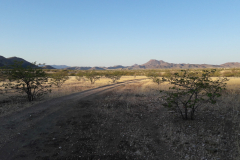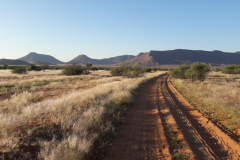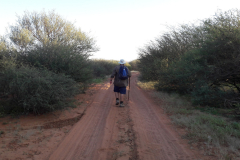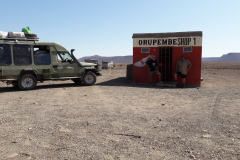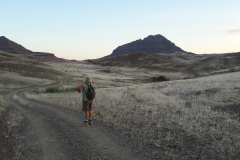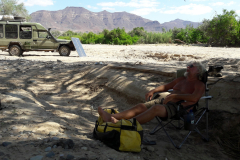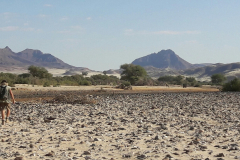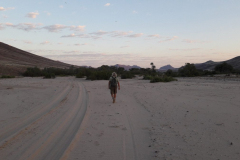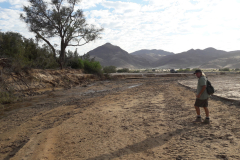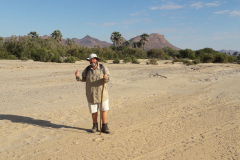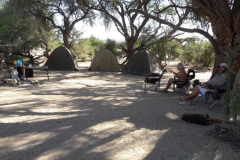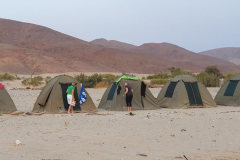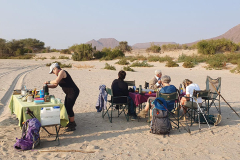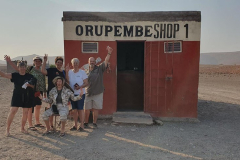The Kaokoveld Camino is part of our Namibia Walking Tours
In 2016, I walked from Swakopmund to the Huab River. I walked up the Skeleton Coast to Cape Cross and I then turned inland to the Messum crater. I passed the Tafelberg and crossed the Ugab River at the Save The Rhino Camp, passing the Mikberg and arriving at the Huab River.
A year later, I decided to do my dream walk: from the Hoanib River to the Kunene River, through the Kaokoveld. This is truly the ultimate wilderness trail in Namibia. 222km long. 16 Days with transport.
I have always loved the Kaokoveld, and since the first time I went there I have wanted to walk there. I decided to walk with a friend. The perfect candidate was my artist/rock god friend Stephen van der Schyff. He is simply a good human, chilled and funny.
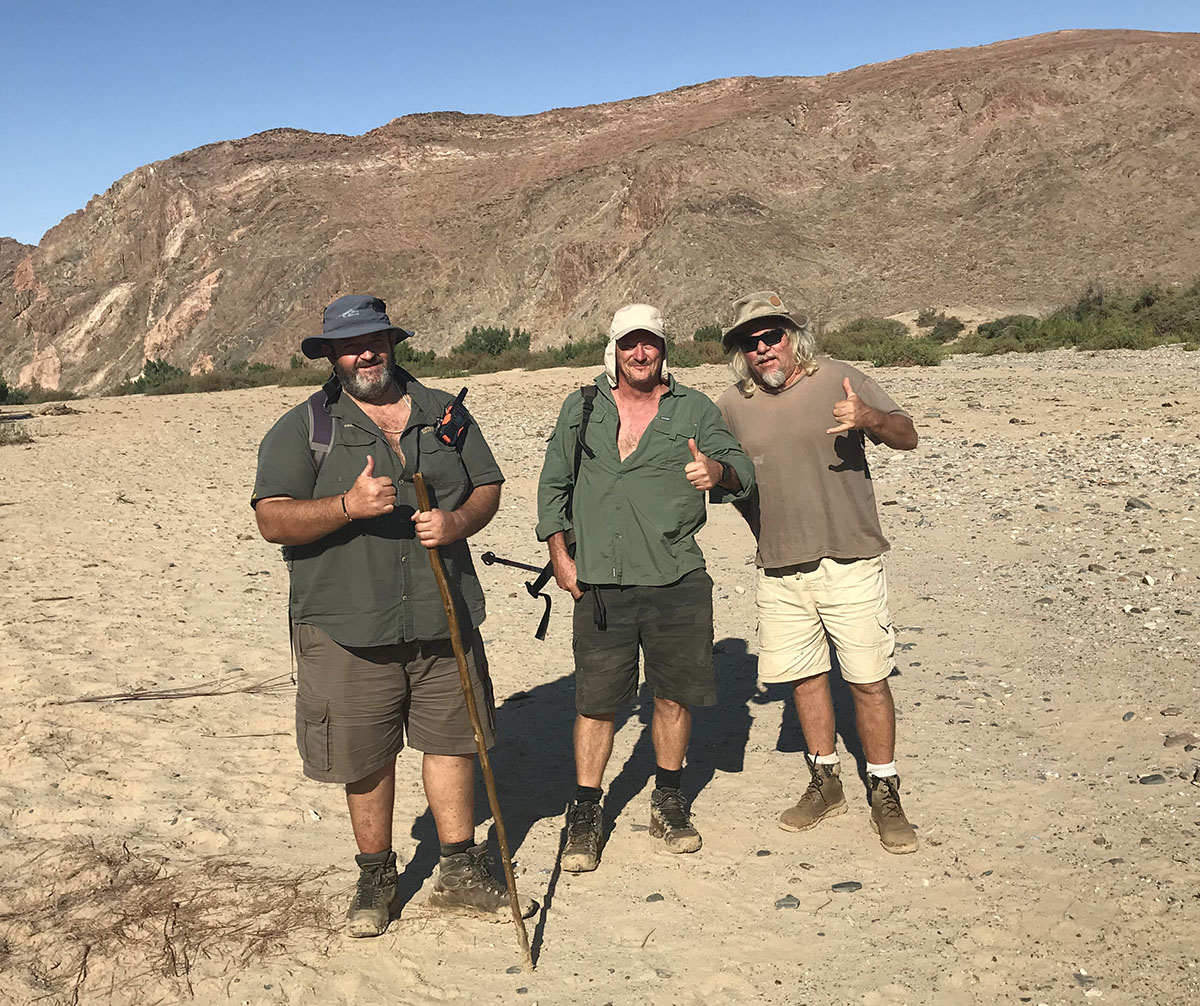
A year later Len Kohler, Steve & myself walked the length of the Hoarusib river. Also an incredible experience.
It was one of the most incredible times of my life. This area is extremely remote and has a very small population. The Himba people there live a traditional lifestyle, largely avoiding modern ways. The terrain is very varied and possibly one of the most beautiful places on earth. It is everything you need out of an adventure. I loved it.
So, I have decided to share this walk/Camino with others in the hope that they find some peace, wellness, mindfulness, self-love, forgiveness, and friendship, just like I did. Despite the logistical challenges involved – a two-day drive from and returning to Windhoek for me and the guests – it is worth every step. It was for me, and it will be one of the highlights of your life.
I walked it in May, however August is the perfect month to visit. Our walk was 300 km, and it took us 22 days. I will run one of these a year in August. For the Kaokoveld Camino, we will start our walk in Puros and it is then 222 km to the Kunene.
The Kaokoveld Camino starts and ends in Windhoek. You need to be there the day before. Pickup starts from 6 am and we will get back to Windhoek late. So please don’t book flights for first and last days of the Camino.
We will provide 4×4 transport to the Kaokoveld and back in 8-seater safari vehicles. Also, due to the remoteness of the area, they will stay with us all the way through the Camino.
While walking, you will only carry your day bag, as all luggage and kit travels on the vehicle. All camp chores are done by the staff: they erect tents and camp, cook, clean, etc. We provide bush toilets and shower cubicles. A loo with a view!
You can book a single or shared tent. Each tent has a camp bed, mattress and mattress cover per person. You bring your own sleeping bag and pillow.
It can be cold at night and during the early morning, so bring some warm clothes. You will also need a torch, spare boot laces, sunblock, hat, insect spray, biodegradable wet wipes, eco-friendly soap, etc.
Good to Know and What to Bring
The price includes transport from Windhoek to Kaokoveld and back in 4×4 vehicles, a 24-hour back up team, and your guide.
It also includes the use of a 2.1×2.1×2.1 safari dome tent equipped with a camping bed, mattress, and mattress cover (please bring your own sleeping bag and pillow), all cutlery, camping chair and more. In the afternoons there is a 10m x 6m shade net to protect us from sun and heat – here you can relax, read, write, chat and just simply enjoy. 3 meals a day made with love are included. This is a slackpacking Camino, you carry only your day bag and we do the rest: we cook, clean, set up camp and tents, etc. I carry a 24 hour GPS emergency messaging system. However, personal travel insurance is essential to provide for medical evacuation in the event of an emergency.
You bring your snacks, drinks & mineral water . We provide water for your showers.
The Kaokoveld is home to the desert adapted elephants, black rhino and giraffe. It is also home to the endemic Cinderella waxbill (Glaucestrilda thomensis).
The indigenous people of Kaokoveld are the Himba people (OvaHimba). Their population is around 50 000 (between northern Namibia and southern Angola) and they are a semi-nomadic tribe that grow crops and have livestock (goats, sheep and cattle). Cattle are most highly prized, as they are the measure of wealth in Himba culture. The OvaHimba relocate according to the rainfall and water accessibility, and are considered the last (semi-) nomadic people of Namibia.
The OvaHimba people have a very distinctive traditional dress. It complements the semi-arid climate of the area. It is made up of a simple skirt, normally made out of calf skin, and sandals made out of old car tyres or cow skin. The ladies, especially, wear a covering of Otjize paste on their skin, which is a mixture of fat and ochre. It colours the skin reddish-brown, and has an aromatic smell. It cleanses and conditions the skin and protects them from the sun, the harsh environment, and insect bites.
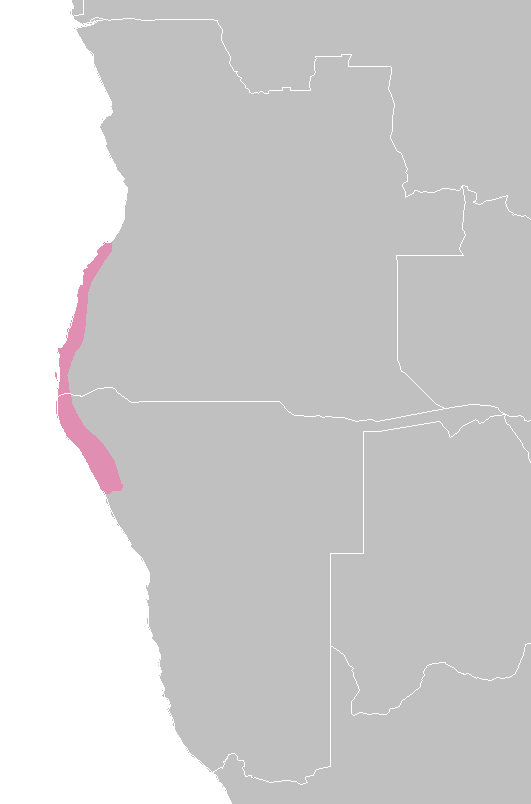

Why the Kaokoveld Camino is the ultimate wilderness trail in Namibia.
Day 1
Pick-up from your accommodation in Windhoek and travel via Okahandja, Ojiwarongo, Outjo and Kamanjab to Palmwag Camping Lodge. Rest of the afternoon at leisure.
Hang by the pool or sit on the deck waiting for the desert elephants while sipping a Gin & Tonic.
Day 2
Travel via Warmquelle and the little dusty town of Sesfontein to Puros. You have the rest of afternoon to find your feet and prepare your walking gear. We will then do a late afternoon scenic drive through the Puros Canyon.
Day 3
Today is the start of the walking on the Kaokoveld Camino. We walk 20 km up the Hoarusib River. This river is a very important water source for the cattle and people of Puros. It flows all year round but mostly underground. Often you will come across the local Himba people digging for water. We wild camp in the riverbed and reflect on our first day’s walking.
Day 4
We start early and walk up the Hoarusib River and see if we find any of the desert elephants or perhaps even a lion. Wild camping in the riverbed.
Day 5
We leave the hoarusib river and walk up and over Mount Himba to the Khumib river. This is a 22 km walk today. It is one of the hardest but also one of the loveliest days. Wild camping in the Khumib river.
Day 6
We do a full day walking up the Khumib river today. We will start to see more and more Himba living in their traditional way. Wild camping.
Day 7
We walk up the Khumib river to the little village of Orupembe. We stop at Shop 1 for a welcome coke or quart of beer. Wild camping in the Khumib river.
Day 8
We walk east and spend an easy day’s walking on gravel tracks and enjoy the scenery. Wild camping en route.
Day 9
Today’s walk takes us past local farms and we see the rural communities working in the field. We walk on to Marble Mine and stay at the camp site there where you can enjoy the facilities.
We visit the marble mining site and the incredible blocks of marble. Unfortunately, the transport costs from this remote area makes it not viable to run the mine.
Day 10
We cross some rocky terrain, and we will certainly start to see some the rural Himba still living in their traditional way and herding the goats. Most won’t speak any English but are very friendly when approached. We camp in a riverbed in the Joubert mountains.
Day 11
Today, we walk up to Red Drum. We walk through the Joubert Pass and this is a very scenic section. You may also catch a glimpse of the famous stone men of the Kaokoveld. Stone Sculptures by a local artist that have been placed in some interesting poses. We walk to the intersection of the Marienfluss and the Schoeman’s Valley. At Red Drum, we see a lot more Himba and wild camp overnight at the beginning of the Marienfluss.
Day 12
Today we walk along the unbelievably beautiful Marienfluss with its plains and the distant mountains. Wild camping in the Marienfluss.
Day 13
The sunrises and sunsets of the Nangolo Flats are spectacular. We spend the day walking and camping at night in this magnificent area.
Day 14
Today is our final day and the last part of the Marienfluss. We end our Camino at the Kunene River and celebrate our achievement at one of the local community camp sites.
Day 15
After a well-deserved sleep we travel down to Sesfontein and out of the Kaokoveld. It is our last night camping before finishing this Camino.
Day 16
We arrive back in Windhoek and say goodbye to new friends and reflect on the incredible adventure we have just experienced.
Pricing
N$27 000 Per Person Sharing
N$29 000 Single
2024 Dates
5 to 20 August 2024
SADC residents get 10% discount.
Returning Camino hikers get 20% discount.
I take a maximum of 16 hikers. Dates are available for private groups.
Minimum 10 hikers.
Fill in this form to make a booking
